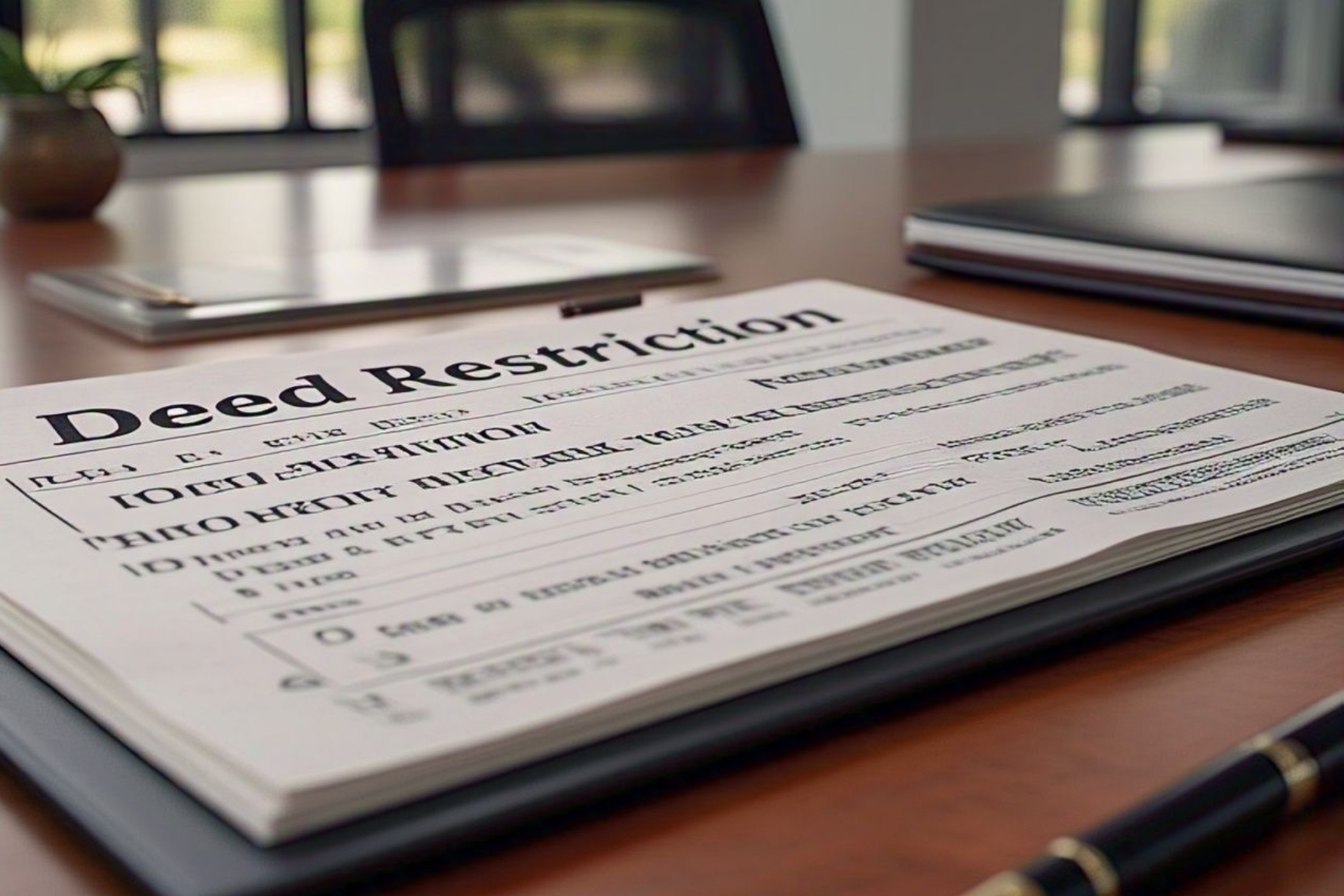Finding and Verify Deed Restrictions on a Property: A Comprehensive Guide
When purchasing a property, understanding its deed restrictions is crucial for ensuring that your plans align with legal and community standards. Deed restrictions are binding limitations written into the property’s deed that can affect everything from building alterations to land use. To find out that if there is deed restrictions on a property, start by checking the property’s deed. This document, available from the county recorder’s office or their online database, will list any deed restrictions attached to the property. You can also review a title report, which often includes information about deed restrictions. Additionally, searching public records at the local courthouse or online can reveal whether there are any deed restrictions on the property. These steps will help you determine if the property is subject to any limitations or rules.
If you have deed restrictions for your property , the first step is to carefully review the specific rules outlined in your deed to understand what is required or prohibited. Ensure you comply with these deed restrictions to avoid potential legal issues or fines. If you need to make changes or have questions about how the restrictions affect your property, consult with a real estate attorney who can provide guidance and help interpret the terms. If you believe the deed restrictions are too restrictive or no longer applicable, you might explore the process for modifying or removing them, which typically requires the agreement of all affected parties and may involve legal procedures. Always check with the county recorder’s office or local authorities to understand the exact steps for managing deed restricted property.
What Is Deed Restricted Property? Understanding the Basics and Key Considerations
Deed-restricted property comes with specific legal constraints that dictate how you can use, alter, or maintain it. These restrictions, outlined in the property’s deed, can significantly impact your plans whether you’re buying, building, or renovating. Understanding deed restrictions is crucial for ensuring compliance and making informed decisions about property management. The fundamentals of deed-restricted properties, including the types of restrictions you may encounter, how to identify them, and key considerations for managing them effectively.
Identifying types of deed restrictions on property
Deed restrictions can address various aspects of property use and maintenance to ensure uniformity and preserve the quality of the neighborhood . there are certain types of deed restrictions
Use restrictions
Use restrictions dictate how a property can be utilized, defining its permitted functions and activities. These restrictions are often implemented to maintain the residential nature of a neighborhood or to ensure that the property is used in a manner that aligns with community standards.
-
Residential Only:
One common deed restriction is that a property must be used solely as a residence. This restriction prevents the property from being used for commercial or business purposes, helping to keep the area quiet and residential. For instance, if a property is in a deed restricted community, the rules might prohibit running a business from home, thus avoiding disturbances like increased traffic or noise.
-
No Rentals:
Some properties have restrictions against renting them out to tenants. These deed restrictions are often used to maintain the character of a neighborhood by ensuring that homes are owner-occupied. It helps in fostering a stable community where homeowners have a vested interest in maintaining their properties.
Architectural Controls
Architectural controls set guidelines for the design and appearance of structures within a development. These deed restrictions are aimed at ensuring that properties conform to a particular aesthetic standard.
- Home Design: Deed restrictions may include specific guidelines on the style, color, or size of homes. For example, there might be rules that require homes to adhere to a particular architectural style, such as Colonial or Modern. There might also be restrictions on exterior paint colors to maintain a uniform look throughout the deed restricted community. This helps prevent designs that could clash with the overall aesthetic of the neighborhood.
- Landscaping: Restrictions may also apply to how gardens and lawns are maintained. This can include rules about acceptable plant types, grass height, and even the installation of features like fences. Such deed restrictions ensure that all properties are kept in a neat and attractive condition, contributing to the overall appeal of the deed restricted neighborhood.
Maintenance Requirements
Maintenance requirements are rules that dictate how a property should be cared for, helping to keep it in good condition and uphold the neighborhood’s standards.
-
Lawn Care;
- These deed restrictions might require homeowners to regularly mow their lawns, trim overgrown shrubs, and manage weeds. Proper lawn care helps maintain a consistent and appealing look across the community, preventing properties from falling into disrepair. Neglecting these requirements could lead to a decline in property values and affect the neighborhood’s overall appearance.
-
Exterior Repairs
Maintenance rules often include keeping the exterior of buildings in good repair. This might involve fixing peeling paint, repairing damaged roofs, or addressing other issues that affect the property’s appearance and safety. Such deed restrictions ensure that properties remain well-maintained and do not detract from the neighborhood’s quality.
How to Manage Deed Restriction
Deed restrictions are crucial legal limitations placed on a property that dictate how it can be used, modified, or maintained. These restrictions are typically established by previous owners, developers, or homeowners associations (HOAs) to preserve certain aspects of a community’s character or ensure uniformity in property appearance and use.To find these restrictions, you should follow a clear process: check the property deed, review title reports, and search public records. Additionally, for properties within HOA communities, understanding the associated Covenants, Conditions, and Restrictions (CC&Rs) is necessary. Knowing how to locate and understand these restrictions is key for making smart choices about buying, renovating, or following community rules.
Checking the Property Deed
The property deed is a fundamental document that provides legal evidence of property ownership. It often includes critical information about deed restrictions that apply to the property. To check for these restrictions:
- Obtain a Copy of the Deed: Request a copy of the property deed from the county recorder’s office or land registry where the property is located. Many jurisdictions also offer online databases where you can search for property deeds. This document will show whether the property is subject to deed restrictions or a deed-restricted sale.
- Review the Deed for Restrictions: Once you have the deed, carefully review it for any mention of deed restrictions. These might be listed under “Restrictions” or “Covenants” and can specify limitations on property use, modifications, or other obligations. Understanding what does deed restricted mean in this context is essential for compliance.
- Interpret the Legal Language: Deeds can contain legal jargon that may be challenging to understand. If you encounter complex terms or unclear provisions, consulting a real estate attorney can help clarify the deed restrictions meaning and any specific deed restriction examples provided in the document.
Reviewing Title Reports
Title reports provide a comprehensive overview of the property’s legal status, including any existing deed restrictions or claims. To use title reports for identifying restrictions:
- Request a Title Report: Title reports are typically prepared by title insurance companies during real estate transactions. If you’re buying property, request a title report from the title company involved. If you already own the property, you can order a title report through a title insurance provider or real estate professional.
- Examine the Report for Restrictions: Title reports often include a section detailing encumbrances on the property, such as easements and deed restrictions. Look for mentions of deed restricted property and how it might affect usage or modifications.
- Consult a Professional: If the title report indicates deed restrictions or if you find it challenging to interpret the report, seek advice from a real estate attorney or title professional. They can provide clarity on deed restrictions vs HOA and other related issues.
Searching Public Records
Public records are a valuable resource for finding information about deed restrictions. Here’s how to search for relevant information:
- Visit the County Recorder’s Office: The county recorder’s office maintains public records related to property ownership and restrictions. You can visit the office in person or use online databases, if available, to search for property records and find any neighborhood deed restrictions or land restrictions.
- Search for Restrictive Covenants: Look for recorded documents such as restrictive covenants or amendments that impose limitations on property use. These documents are often filed as part of the public record and can provide detailed information about deed restrictions.
- Review Historical Records: For properties with long histories, reviewing historical records can help understand how deed restrictions have evolved over time. Some older records may be archived and require additional research.
Understanding Covenants, Conditions, and Restrictions (CC&Rs)
Covenants, Conditions, and Restrictions (CC&Rs) are rules set by homeowners’ associations (HOAs) to maintain the look and feel of a community. These guidelines cover various aspects of property use and maintenance, such as what changes you can make to your home, how to maintain your yard, and what activities are allowed. To understand CC&Rs, get a copy from your HOA and review it for specific rules that apply to your property. Following these rules is important to avoid fines or disputes. If you want to change any of the rules, it typically requires a formal process and approval from other homeowners. Being familiar with CC&Rs helps you stay compliant and keeps your community looking its best.
By following these methods, you can effectively locate and understand deed restrictions, title reports, public records, and CC&Rs, helping you make informed decisions about property use, modifications, and community compliance.
Deed restrictions vs Homeowners’ Associations( HOA ):
Deed restrictions and homeowners’ associations (HOAs) both set rules for property use and maintenance, but they operate differently
Deed Restrictions:
These are specific rules included in a property’s deed that apply to the property regardless of who owns it. They are created by the original owner or developer and are recorded with the county to be legally binding. Deed restrictions often cover things like architectural styles, property usage, or maintenance requirements. They are enforced through legal channels, and changing them usually requires a formal process involving all affected parties.
HOAs: Homeowners’ associations:
These are organizations that manage and enforce community rules for a group of properties, usually within a planned community or subdivision. HOAs set rules and regulations, such as landscaping standards or community behavior guidelines, and collect fees from homeowners to fund community maintenance and services. They have the authority to enforce these rules and can impose fines or other penalties for non-compliance. Unlike deed restrictions, HOA rules can be updated or changed more easily by the association’s board.
How to put a deed restriction on a property:
Adding a deed restriction to a property involves placing specific limitations or conditions directly into the property’s deed to control how it can be used or modified. It involve following certain steps if you decide to put a deed restriction on a property
-
Understand What Deed Restrictions Are:
Deed restrictions are legal limitations placed on a property by the owner or developer to maintain certain standards or characteristics. For example, a deed-restricted property might have rules about the type of buildings that can be constructed or how the property can be maintained.
-
Decide on the Restriction:
Determine what kind of deed restriction you want to apply. This could involve rules about property use, such as preventing commercial activities in a residential area, or aesthetic guidelines to maintain the appearance of a deed-restricted community. This is known as a deed restriction example.
-
Draft the Restriction:
Write a clear and specific deed restriction. Ensure the language is precise to avoid ambiguity. For instance, if you want to restrict alterations to the property, specify exactly what modifications are prohibited.
-
Record the Restriction:
To make the restriction legally binding, you must record it with the county recorder’s office where the property is located. This action updates the public record and informs future property owners of the deed restrictions.
-
Enforce and Modify:
Deed restrictions are enforceable by anyone with an interest in the property, such as neighbors or homeowner associations (HOAs). If you’re part of a deed-restricted community, the HOA might enforce these rules. If changes are needed, deed restrictions can sometimes be altered or removed, but this typically requires agreement from all affected parties and proper legal procedures.
-
Check Local Laws:
Different areas have different rules about deed restrictions. For example, in Florida deed-restricted communities, local laws might affect how these restrictions are handled. Deed restrictions Texas might also have specific requirements. Understanding these local regulations ensures that your deed restriction is valid and enforceable.
By following these steps, you can successfully implement a deed restriction to control how a property is used or maintained, creating a harmonious environment in a deed-restricted neighborhood or deed-restricted community.
What are Deed Restrictions Commercial Property?
Deed restrictions on commercial property are specific rules placed on the property that dictate how it can be used, developed, or modified. These deed restrictions can limit the types of businesses that can operate, control the physical changes made to the property, or impose other conditions to maintain a particular standard or character within the area. For example, a deed restricted commercial property might prohibit certain types of businesses, such as bars or nightclubs, to ensure a family-friendly environment. To ensure compliance, it’s crucial to review the deed restrictions detailed in the property’s deed and consult with a legal expert if needed. Understanding these restrictions is essential for making informed decisions about operating or investing in deed restricted commercial property.
Who creates deed restrictions on a property:
Deed restrictions on a property are typically created by the original property owner or developer. When a property is first developed or sold, the owner or developer may include deed restrictions in the property’s deed to control how the property can be used or maintained.
For example, a developer might impose deed restrictions to ensure that all homes in a new neighborhood meet certain design standards. Similarly, an individual property owner might add deed restrictions to prevent future owners from making undesirable changes.
In some cases, homeowners’ associations (HOAs) or other community organizations may also impose deed restrictions to maintain neighborhood standards. To create or modify these restrictions, the responsible party must draft the rules and record them with the county recorder’s office or relevant local authority, making them legally binding and enforceable.
Texas Property Code: Changing Deed Restrictions
In Texas, changing deed restrictions involves a legal process governed by the Texas Property Code and other relevant statutes.Changing deed restrictions under the Texas Property Code requires a structured approach to ensure legal and transparent modifications to property rules.
- Reviewing Existing Deed Restrictions
Begin by thoroughly reviewing the current deed restrictions recorded in the property’s deed. Understanding these existing rules is essential to determine which restrictions you want to amend or remove. This review will help clarify what deed restrictions mean for your specific deed restricted property and identify deed restriction examples relevant to your case.
- Drafting Amendments
After understanding the existing deed restrictions, draft an amendment to modify or remove certain terms. This document should clearly specify the changes to the original deed restrictions and be precise to ensure it reflects the intended adjustments accurately. Proper drafting is crucial to address what does deed restriced mean in the new context. -
Obtaining Consent
In a deed restricted community, you often need to obtain consent from other property owners impacted by the deed restrictions. This is necessary because changes usually affect multiple deed restricted units. Consent requirements may be outlined in the original deed or community agreements. This step helps ensure that changes align with the interests of all affected parties.
-
Recording the Changes
Once the amendment is drafted and approved, record it with the county clerk or appropriate local authority. Filing the amended deed with the county recorder’s office updates the public record and makes the new deed restrictions legally binding. This step is essential to ensure that the changes are officially recognized and enforceable.
-
Legal Considerations
Navigating the legal aspects of changing deed restrictions can be complex. Consulting a real estate attorney is advisable to ensure compliance with the Texas Property Code and to address any legal issues that may arise. An attorney can provide guidance on how can deed restrictions be changed or removed effectively.
-
Community and Association Involvement
In developments with a homeowners’ association (HOA) or community board, additional procedures may apply. These organizations might have their own rules for changing deed restrictions. Understanding deed restrictions vs HOA can help ensure you follow all necessary steps for compliance.
In summary, changing deed restrictions under the Texas Property Code involves reviewing existing restrictions, drafting precise amendments, obtaining necessary consents, recording changes, and addressing legal considerations. Following these steps ensures that the new deed restrictions are properly implemented and enforceable.
Conclusion :
In conclusion, understanding deed restrictions is crucial for anyone dealing with a deed restricted property. These restrictions are specific rules that dictate how a property can be used or modified, ensuring uniformity and preserving community standards. Whether you are exploring what deed restrictions mean for your deed restricted community or navigating the process of how deed restrictions can be changed or removed, knowing what deed restrictions mean helps in making informed decisions. From deed restriction examples to the differences between deed restrictions vs HOA, grasping these concepts ensures you remain compliant and make the most out of your property investment. For a deed restricted sale or if you’re curious about deed restrictions Texas, the process involves careful review and adherence to legal requirements, reinforcing the importance of being well-informed about the deed restrictions’ meaning and implications for your property.



